International Trade: Sizzling Chicken's Global Expansion Strategy
VerifiedAdded on 2023/06/15
|13
|2446
|182
Report
AI Summary
This report evaluates international expansion opportunities for "Sizzling Chicken," a Canadian fast-food restaurant chain specializing in charcoal-grilled chicken. It assesses Australia, India, and Pakistan based on their economic, cultural, legal, and political environments. Key factors considered include potential profitability, competitive pressure, the need for local customization, cost reduction opportunities, and associated risks. India emerges as the most attractive market due to its large customer base, lower labor costs, and acceptance of the menu. The proposed expansion strategy for India involves penetration pricing, a business-to-customer distribution model, and maintaining the original brand. The report recommends a divisional organizational structure to leverage specialized employee skills, with marketing strategies tailored to the competitive landscape. The analysis concludes that India offers the best prospects for profitable and efficient expansion.

Running head: INTERNATIONAL TRADE
International Trade
Name of the Student:
Name of the University:
Authors Note:
International Trade
Name of the Student:
Name of the University:
Authors Note:
Paraphrase This Document
Need a fresh take? Get an instant paraphrase of this document with our AI Paraphraser
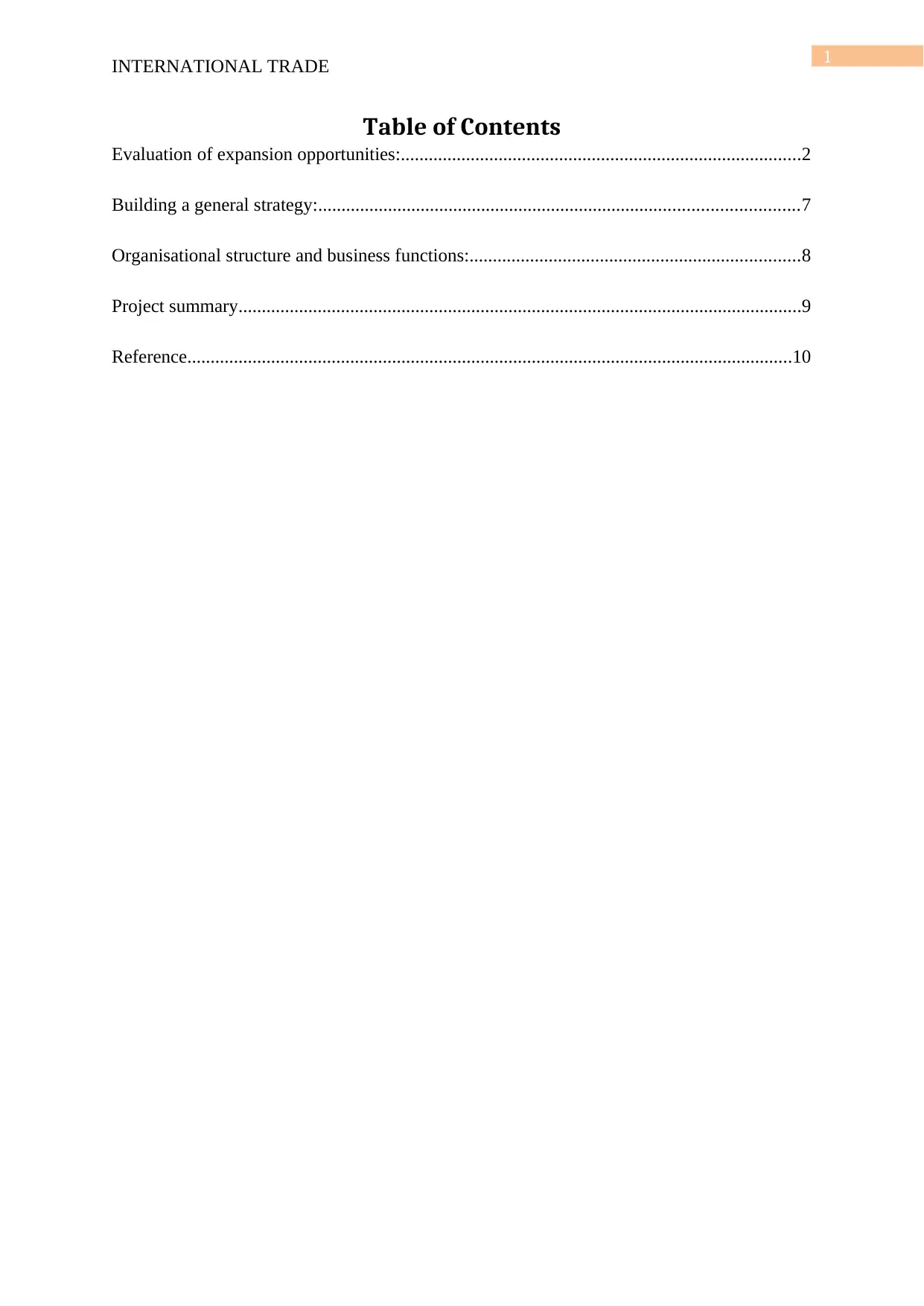
1
INTERNATIONAL TRADE
Table of Contents
Evaluation of expansion opportunities:......................................................................................2
Building a general strategy:.......................................................................................................7
Organisational structure and business functions:.......................................................................8
Project summary.........................................................................................................................9
Reference..................................................................................................................................10
INTERNATIONAL TRADE
Table of Contents
Evaluation of expansion opportunities:......................................................................................2
Building a general strategy:.......................................................................................................7
Organisational structure and business functions:.......................................................................8
Project summary.........................................................................................................................9
Reference..................................................................................................................................10
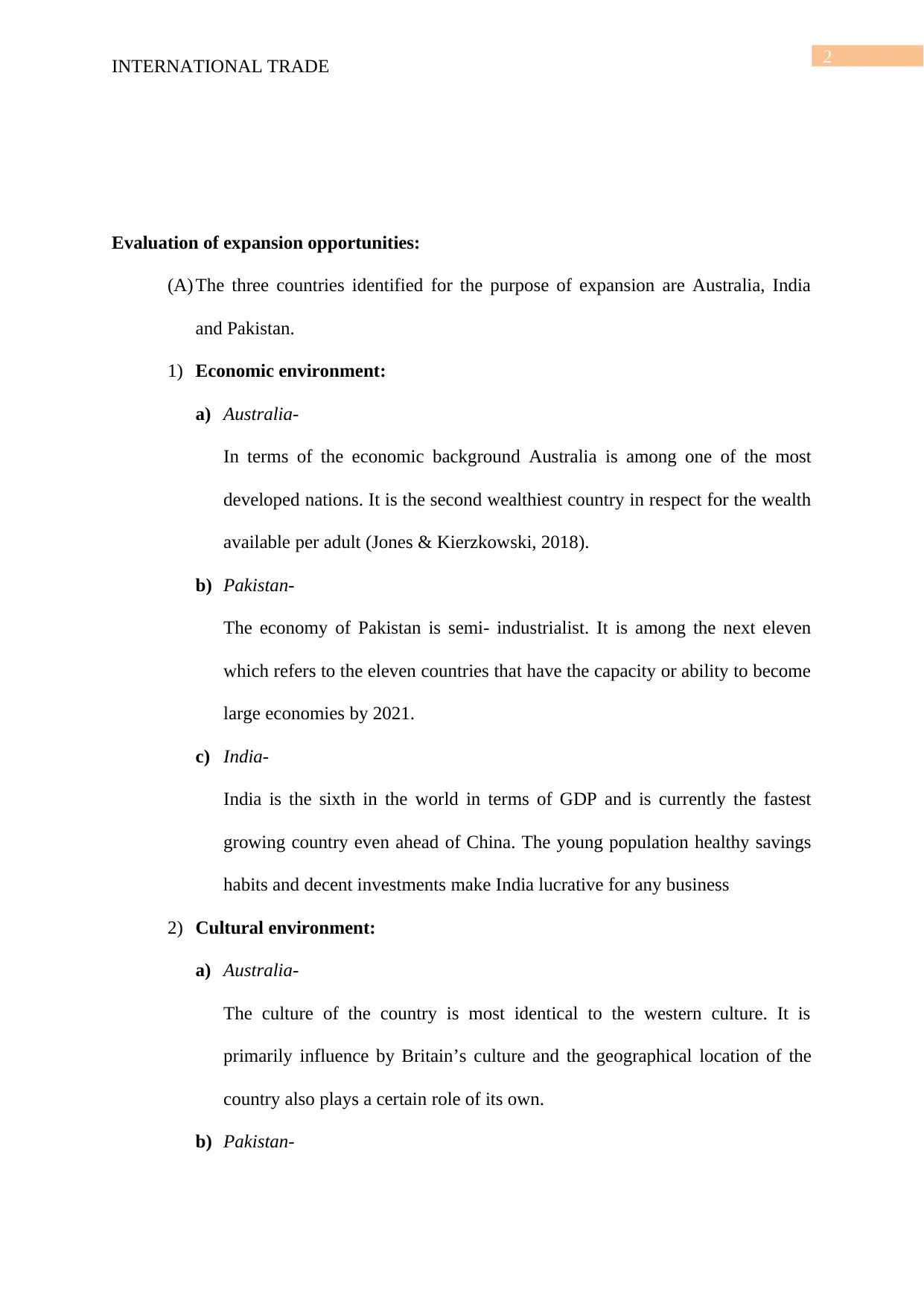
2
INTERNATIONAL TRADE
Evaluation of expansion opportunities:
(A) The three countries identified for the purpose of expansion are Australia, India
and Pakistan.
1) Economic environment:
a) Australia-
In terms of the economic background Australia is among one of the most
developed nations. It is the second wealthiest country in respect for the wealth
available per adult (Jones & Kierzkowski, 2018).
b) Pakistan-
The economy of Pakistan is semi- industrialist. It is among the next eleven
which refers to the eleven countries that have the capacity or ability to become
large economies by 2021.
c) India-
India is the sixth in the world in terms of GDP and is currently the fastest
growing country even ahead of China. The young population healthy savings
habits and decent investments make India lucrative for any business
2) Cultural environment:
a) Australia-
The culture of the country is most identical to the western culture. It is
primarily influence by Britain’s culture and the geographical location of the
country also plays a certain role of its own.
b) Pakistan-
INTERNATIONAL TRADE
Evaluation of expansion opportunities:
(A) The three countries identified for the purpose of expansion are Australia, India
and Pakistan.
1) Economic environment:
a) Australia-
In terms of the economic background Australia is among one of the most
developed nations. It is the second wealthiest country in respect for the wealth
available per adult (Jones & Kierzkowski, 2018).
b) Pakistan-
The economy of Pakistan is semi- industrialist. It is among the next eleven
which refers to the eleven countries that have the capacity or ability to become
large economies by 2021.
c) India-
India is the sixth in the world in terms of GDP and is currently the fastest
growing country even ahead of China. The young population healthy savings
habits and decent investments make India lucrative for any business
2) Cultural environment:
a) Australia-
The culture of the country is most identical to the western culture. It is
primarily influence by Britain’s culture and the geographical location of the
country also plays a certain role of its own.
b) Pakistan-
⊘ This is a preview!⊘
Do you want full access?
Subscribe today to unlock all pages.

Trusted by 1+ million students worldwide
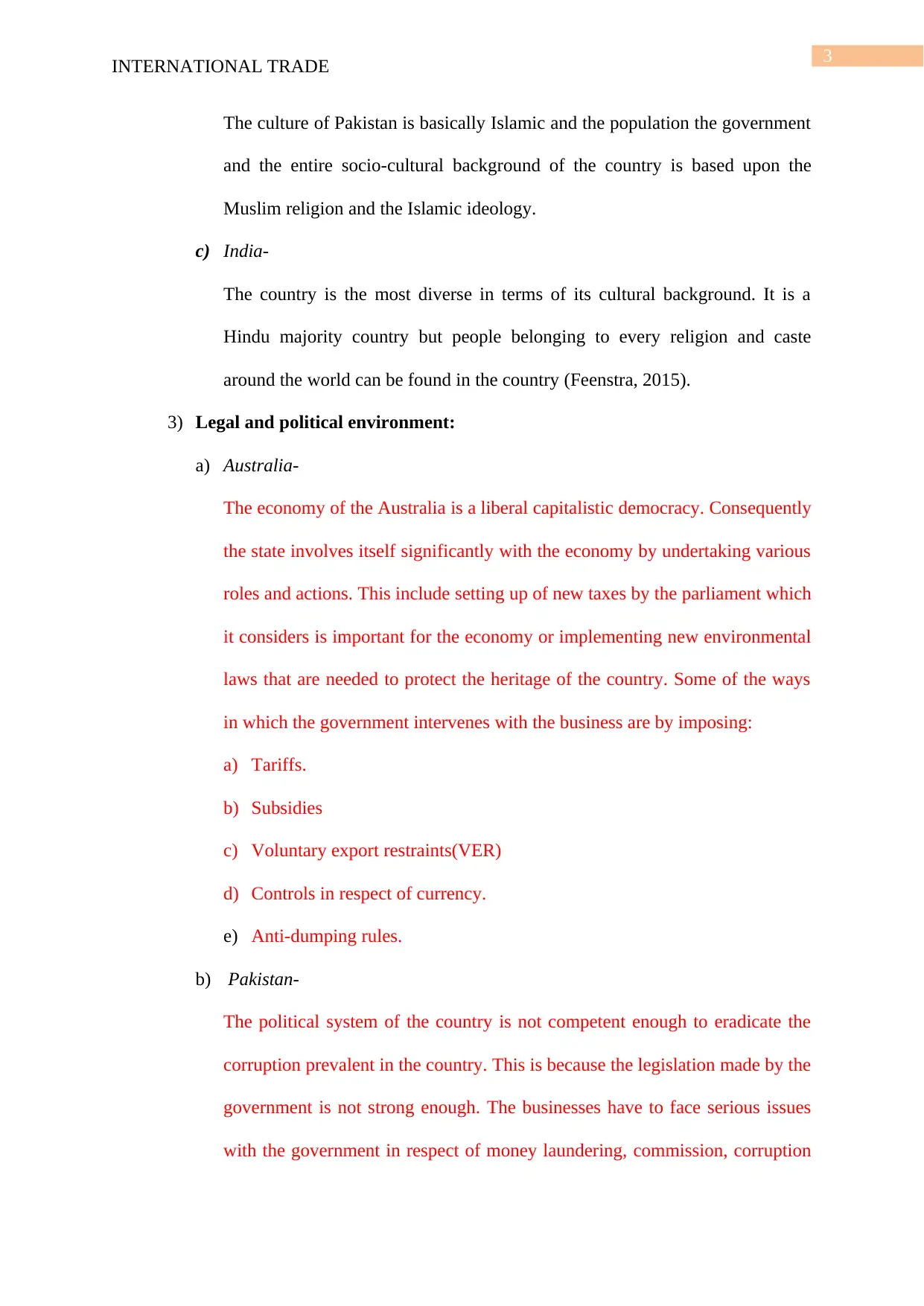
3
INTERNATIONAL TRADE
The culture of Pakistan is basically Islamic and the population the government
and the entire socio-cultural background of the country is based upon the
Muslim religion and the Islamic ideology.
c) India-
The country is the most diverse in terms of its cultural background. It is a
Hindu majority country but people belonging to every religion and caste
around the world can be found in the country (Feenstra, 2015).
3) Legal and political environment:
a) Australia-
The economy of the Australia is a liberal capitalistic democracy. Consequently
the state involves itself significantly with the economy by undertaking various
roles and actions. This include setting up of new taxes by the parliament which
it considers is important for the economy or implementing new environmental
laws that are needed to protect the heritage of the country. Some of the ways
in which the government intervenes with the business are by imposing:
a) Tariffs.
b) Subsidies
c) Voluntary export restraints(VER)
d) Controls in respect of currency.
e) Anti-dumping rules.
b) Pakistan-
The political system of the country is not competent enough to eradicate the
corruption prevalent in the country. This is because the legislation made by the
government is not strong enough. The businesses have to face serious issues
with the government in respect of money laundering, commission, corruption
INTERNATIONAL TRADE
The culture of Pakistan is basically Islamic and the population the government
and the entire socio-cultural background of the country is based upon the
Muslim religion and the Islamic ideology.
c) India-
The country is the most diverse in terms of its cultural background. It is a
Hindu majority country but people belonging to every religion and caste
around the world can be found in the country (Feenstra, 2015).
3) Legal and political environment:
a) Australia-
The economy of the Australia is a liberal capitalistic democracy. Consequently
the state involves itself significantly with the economy by undertaking various
roles and actions. This include setting up of new taxes by the parliament which
it considers is important for the economy or implementing new environmental
laws that are needed to protect the heritage of the country. Some of the ways
in which the government intervenes with the business are by imposing:
a) Tariffs.
b) Subsidies
c) Voluntary export restraints(VER)
d) Controls in respect of currency.
e) Anti-dumping rules.
b) Pakistan-
The political system of the country is not competent enough to eradicate the
corruption prevalent in the country. This is because the legislation made by the
government is not strong enough. The businesses have to face serious issues
with the government in respect of money laundering, commission, corruption
Paraphrase This Document
Need a fresh take? Get an instant paraphrase of this document with our AI Paraphraser
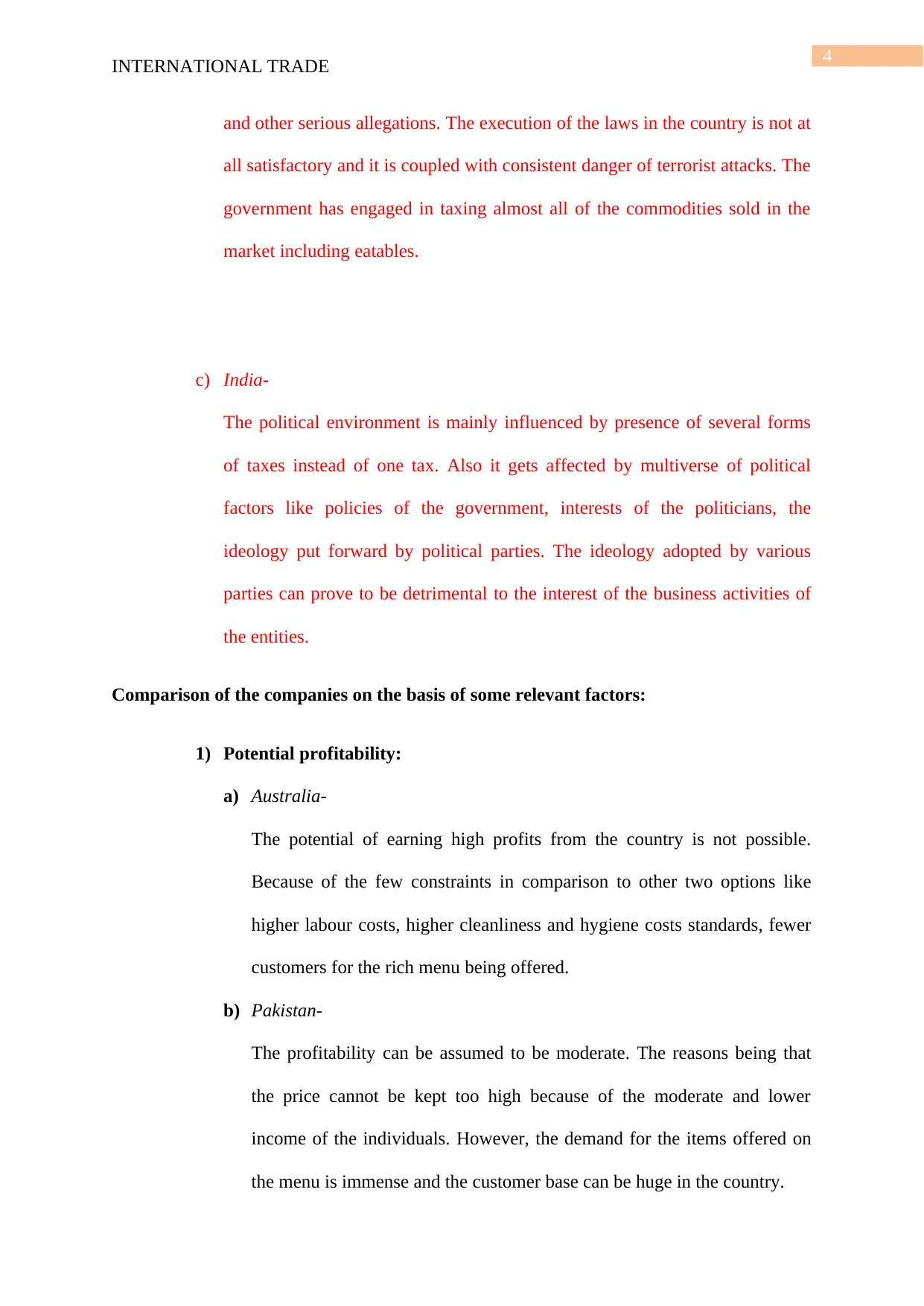
4
INTERNATIONAL TRADE
and other serious allegations. The execution of the laws in the country is not at
all satisfactory and it is coupled with consistent danger of terrorist attacks. The
government has engaged in taxing almost all of the commodities sold in the
market including eatables.
c) India-
The political environment is mainly influenced by presence of several forms
of taxes instead of one tax. Also it gets affected by multiverse of political
factors like policies of the government, interests of the politicians, the
ideology put forward by political parties. The ideology adopted by various
parties can prove to be detrimental to the interest of the business activities of
the entities.
Comparison of the companies on the basis of some relevant factors:
1) Potential profitability:
a) Australia-
The potential of earning high profits from the country is not possible.
Because of the few constraints in comparison to other two options like
higher labour costs, higher cleanliness and hygiene costs standards, fewer
customers for the rich menu being offered.
b) Pakistan-
The profitability can be assumed to be moderate. The reasons being that
the price cannot be kept too high because of the moderate and lower
income of the individuals. However, the demand for the items offered on
the menu is immense and the customer base can be huge in the country.
INTERNATIONAL TRADE
and other serious allegations. The execution of the laws in the country is not at
all satisfactory and it is coupled with consistent danger of terrorist attacks. The
government has engaged in taxing almost all of the commodities sold in the
market including eatables.
c) India-
The political environment is mainly influenced by presence of several forms
of taxes instead of one tax. Also it gets affected by multiverse of political
factors like policies of the government, interests of the politicians, the
ideology put forward by political parties. The ideology adopted by various
parties can prove to be detrimental to the interest of the business activities of
the entities.
Comparison of the companies on the basis of some relevant factors:
1) Potential profitability:
a) Australia-
The potential of earning high profits from the country is not possible.
Because of the few constraints in comparison to other two options like
higher labour costs, higher cleanliness and hygiene costs standards, fewer
customers for the rich menu being offered.
b) Pakistan-
The profitability can be assumed to be moderate. The reasons being that
the price cannot be kept too high because of the moderate and lower
income of the individuals. However, the demand for the items offered on
the menu is immense and the customer base can be huge in the country.
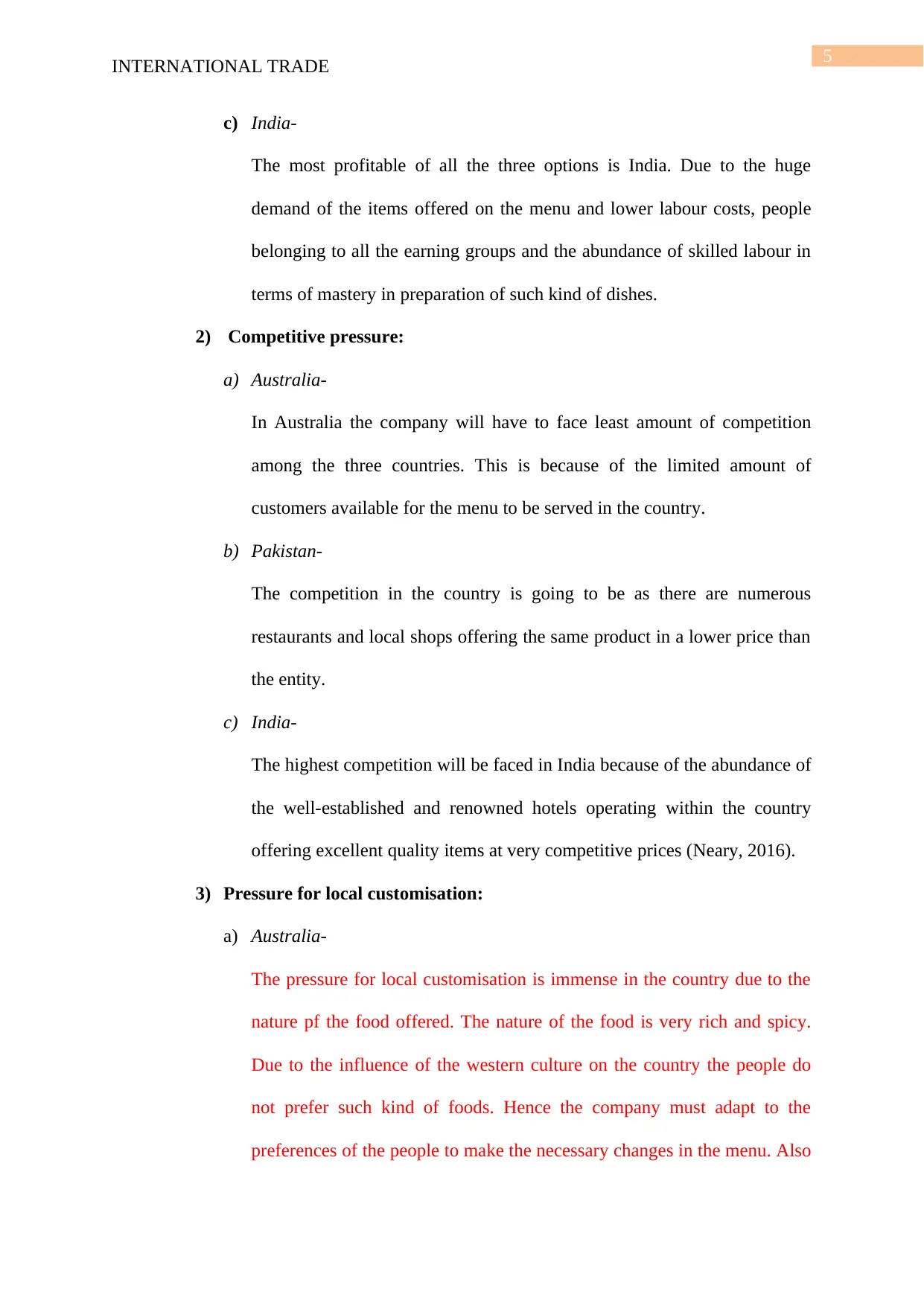
5
INTERNATIONAL TRADE
c) India-
The most profitable of all the three options is India. Due to the huge
demand of the items offered on the menu and lower labour costs, people
belonging to all the earning groups and the abundance of skilled labour in
terms of mastery in preparation of such kind of dishes.
2) Competitive pressure:
a) Australia-
In Australia the company will have to face least amount of competition
among the three countries. This is because of the limited amount of
customers available for the menu to be served in the country.
b) Pakistan-
The competition in the country is going to be as there are numerous
restaurants and local shops offering the same product in a lower price than
the entity.
c) India-
The highest competition will be faced in India because of the abundance of
the well-established and renowned hotels operating within the country
offering excellent quality items at very competitive prices (Neary, 2016).
3) Pressure for local customisation:
a) Australia-
The pressure for local customisation is immense in the country due to the
nature pf the food offered. The nature of the food is very rich and spicy.
Due to the influence of the western culture on the country the people do
not prefer such kind of foods. Hence the company must adapt to the
preferences of the people to make the necessary changes in the menu. Also
INTERNATIONAL TRADE
c) India-
The most profitable of all the three options is India. Due to the huge
demand of the items offered on the menu and lower labour costs, people
belonging to all the earning groups and the abundance of skilled labour in
terms of mastery in preparation of such kind of dishes.
2) Competitive pressure:
a) Australia-
In Australia the company will have to face least amount of competition
among the three countries. This is because of the limited amount of
customers available for the menu to be served in the country.
b) Pakistan-
The competition in the country is going to be as there are numerous
restaurants and local shops offering the same product in a lower price than
the entity.
c) India-
The highest competition will be faced in India because of the abundance of
the well-established and renowned hotels operating within the country
offering excellent quality items at very competitive prices (Neary, 2016).
3) Pressure for local customisation:
a) Australia-
The pressure for local customisation is immense in the country due to the
nature pf the food offered. The nature of the food is very rich and spicy.
Due to the influence of the western culture on the country the people do
not prefer such kind of foods. Hence the company must adapt to the
preferences of the people to make the necessary changes in the menu. Also
⊘ This is a preview!⊘
Do you want full access?
Subscribe today to unlock all pages.

Trusted by 1+ million students worldwide
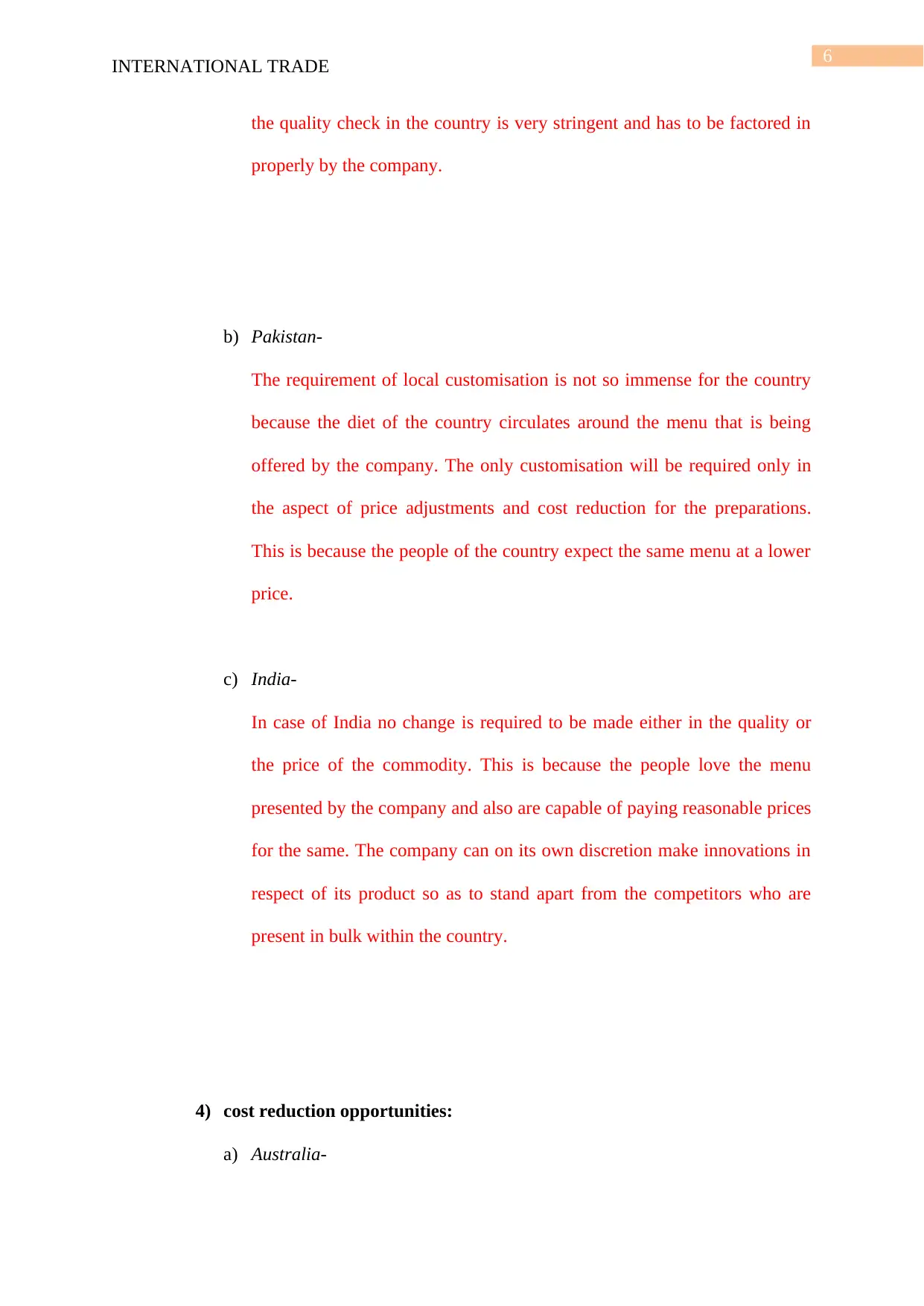
6
INTERNATIONAL TRADE
the quality check in the country is very stringent and has to be factored in
properly by the company.
b) Pakistan-
The requirement of local customisation is not so immense for the country
because the diet of the country circulates around the menu that is being
offered by the company. The only customisation will be required only in
the aspect of price adjustments and cost reduction for the preparations.
This is because the people of the country expect the same menu at a lower
price.
c) India-
In case of India no change is required to be made either in the quality or
the price of the commodity. This is because the people love the menu
presented by the company and also are capable of paying reasonable prices
for the same. The company can on its own discretion make innovations in
respect of its product so as to stand apart from the competitors who are
present in bulk within the country.
4) cost reduction opportunities:
a) Australia-
INTERNATIONAL TRADE
the quality check in the country is very stringent and has to be factored in
properly by the company.
b) Pakistan-
The requirement of local customisation is not so immense for the country
because the diet of the country circulates around the menu that is being
offered by the company. The only customisation will be required only in
the aspect of price adjustments and cost reduction for the preparations.
This is because the people of the country expect the same menu at a lower
price.
c) India-
In case of India no change is required to be made either in the quality or
the price of the commodity. This is because the people love the menu
presented by the company and also are capable of paying reasonable prices
for the same. The company can on its own discretion make innovations in
respect of its product so as to stand apart from the competitors who are
present in bulk within the country.
4) cost reduction opportunities:
a) Australia-
Paraphrase This Document
Need a fresh take? Get an instant paraphrase of this document with our AI Paraphraser
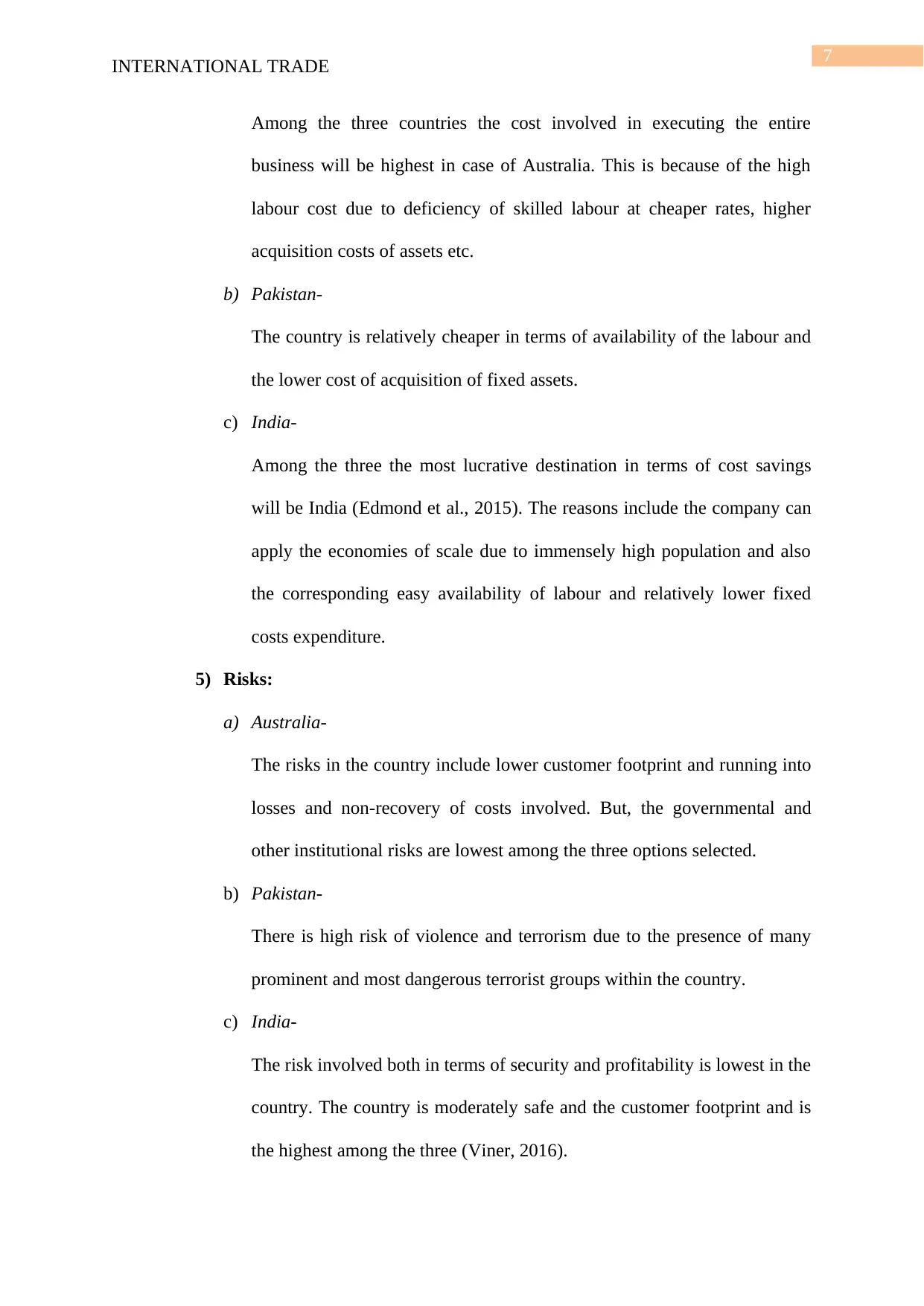
7
INTERNATIONAL TRADE
Among the three countries the cost involved in executing the entire
business will be highest in case of Australia. This is because of the high
labour cost due to deficiency of skilled labour at cheaper rates, higher
acquisition costs of assets etc.
b) Pakistan-
The country is relatively cheaper in terms of availability of the labour and
the lower cost of acquisition of fixed assets.
c) India-
Among the three the most lucrative destination in terms of cost savings
will be India (Edmond et al., 2015). The reasons include the company can
apply the economies of scale due to immensely high population and also
the corresponding easy availability of labour and relatively lower fixed
costs expenditure.
5) Risks:
a) Australia-
The risks in the country include lower customer footprint and running into
losses and non-recovery of costs involved. But, the governmental and
other institutional risks are lowest among the three options selected.
b) Pakistan-
There is high risk of violence and terrorism due to the presence of many
prominent and most dangerous terrorist groups within the country.
c) India-
The risk involved both in terms of security and profitability is lowest in the
country. The country is moderately safe and the customer footprint and is
the highest among the three (Viner, 2016).
INTERNATIONAL TRADE
Among the three countries the cost involved in executing the entire
business will be highest in case of Australia. This is because of the high
labour cost due to deficiency of skilled labour at cheaper rates, higher
acquisition costs of assets etc.
b) Pakistan-
The country is relatively cheaper in terms of availability of the labour and
the lower cost of acquisition of fixed assets.
c) India-
Among the three the most lucrative destination in terms of cost savings
will be India (Edmond et al., 2015). The reasons include the company can
apply the economies of scale due to immensely high population and also
the corresponding easy availability of labour and relatively lower fixed
costs expenditure.
5) Risks:
a) Australia-
The risks in the country include lower customer footprint and running into
losses and non-recovery of costs involved. But, the governmental and
other institutional risks are lowest among the three options selected.
b) Pakistan-
There is high risk of violence and terrorism due to the presence of many
prominent and most dangerous terrorist groups within the country.
c) India-
The risk involved both in terms of security and profitability is lowest in the
country. The country is moderately safe and the customer footprint and is
the highest among the three (Viner, 2016).
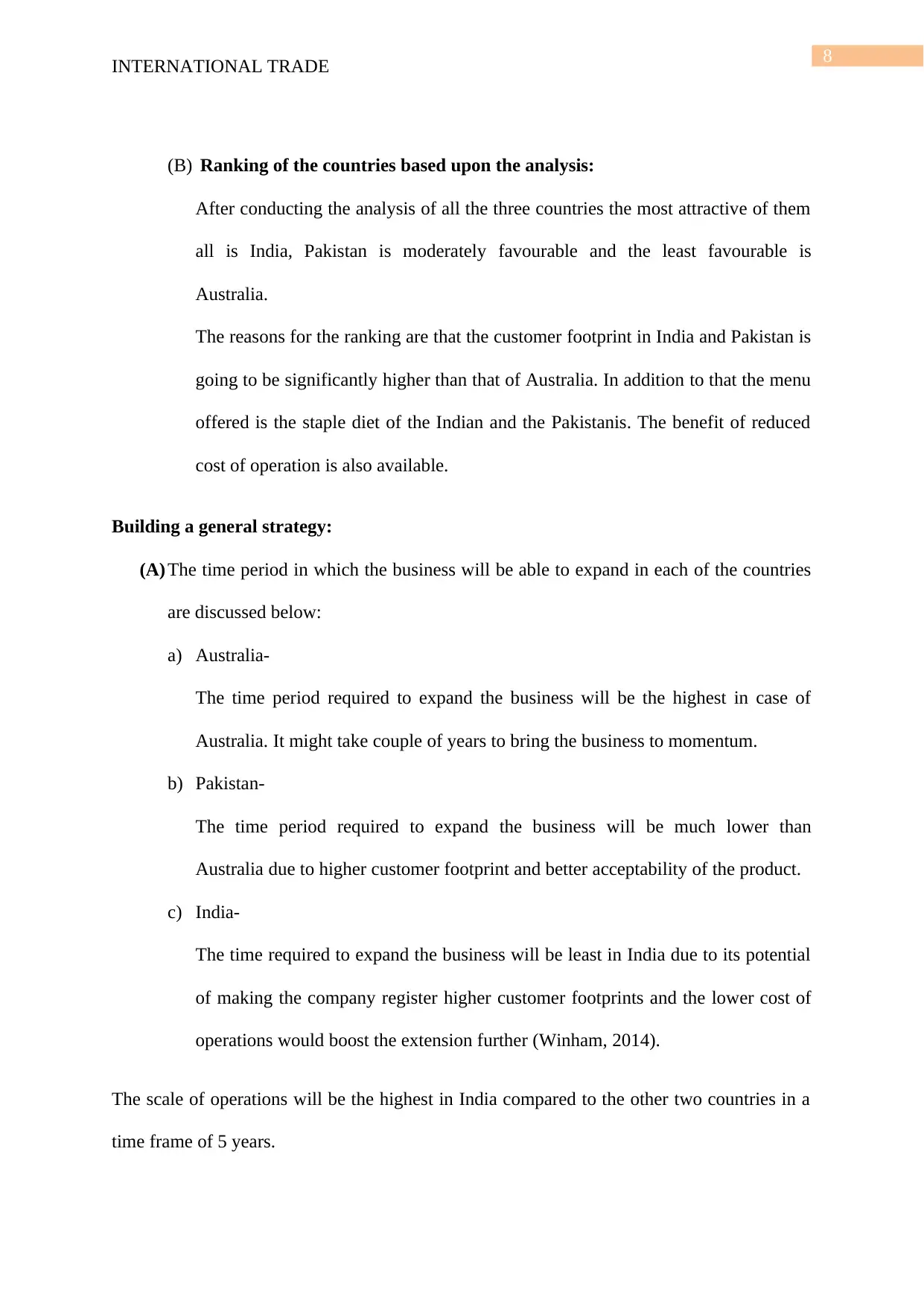
8
INTERNATIONAL TRADE
(B) Ranking of the countries based upon the analysis:
After conducting the analysis of all the three countries the most attractive of them
all is India, Pakistan is moderately favourable and the least favourable is
Australia.
The reasons for the ranking are that the customer footprint in India and Pakistan is
going to be significantly higher than that of Australia. In addition to that the menu
offered is the staple diet of the Indian and the Pakistanis. The benefit of reduced
cost of operation is also available.
Building a general strategy:
(A) The time period in which the business will be able to expand in each of the countries
are discussed below:
a) Australia-
The time period required to expand the business will be the highest in case of
Australia. It might take couple of years to bring the business to momentum.
b) Pakistan-
The time period required to expand the business will be much lower than
Australia due to higher customer footprint and better acceptability of the product.
c) India-
The time required to expand the business will be least in India due to its potential
of making the company register higher customer footprints and the lower cost of
operations would boost the extension further (Winham, 2014).
The scale of operations will be the highest in India compared to the other two countries in a
time frame of 5 years.
INTERNATIONAL TRADE
(B) Ranking of the countries based upon the analysis:
After conducting the analysis of all the three countries the most attractive of them
all is India, Pakistan is moderately favourable and the least favourable is
Australia.
The reasons for the ranking are that the customer footprint in India and Pakistan is
going to be significantly higher than that of Australia. In addition to that the menu
offered is the staple diet of the Indian and the Pakistanis. The benefit of reduced
cost of operation is also available.
Building a general strategy:
(A) The time period in which the business will be able to expand in each of the countries
are discussed below:
a) Australia-
The time period required to expand the business will be the highest in case of
Australia. It might take couple of years to bring the business to momentum.
b) Pakistan-
The time period required to expand the business will be much lower than
Australia due to higher customer footprint and better acceptability of the product.
c) India-
The time required to expand the business will be least in India due to its potential
of making the company register higher customer footprints and the lower cost of
operations would boost the extension further (Winham, 2014).
The scale of operations will be the highest in India compared to the other two countries in a
time frame of 5 years.
⊘ This is a preview!⊘
Do you want full access?
Subscribe today to unlock all pages.

Trusted by 1+ million students worldwide
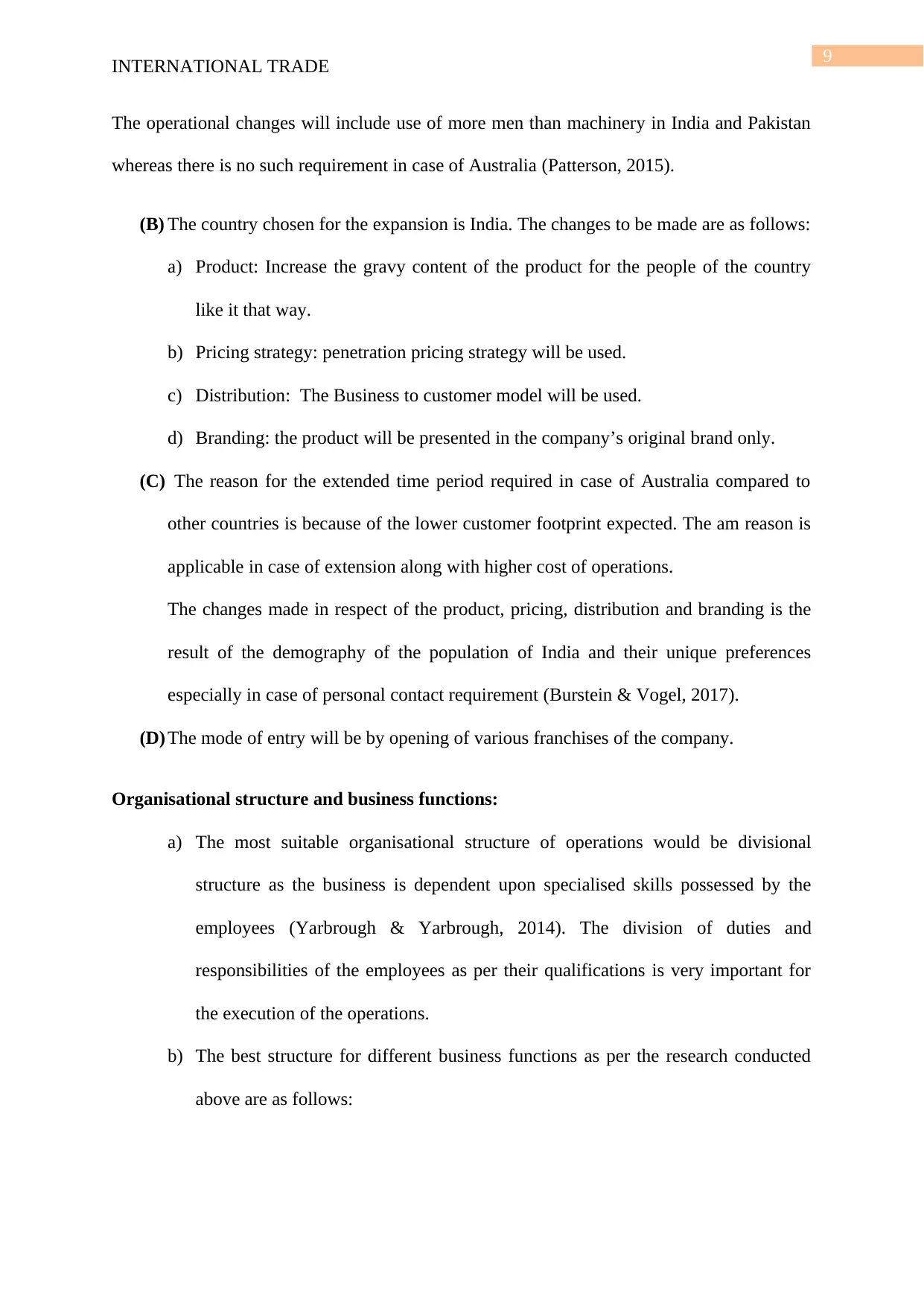
9
INTERNATIONAL TRADE
The operational changes will include use of more men than machinery in India and Pakistan
whereas there is no such requirement in case of Australia (Patterson, 2015).
(B) The country chosen for the expansion is India. The changes to be made are as follows:
a) Product: Increase the gravy content of the product for the people of the country
like it that way.
b) Pricing strategy: penetration pricing strategy will be used.
c) Distribution: The Business to customer model will be used.
d) Branding: the product will be presented in the company’s original brand only.
(C) The reason for the extended time period required in case of Australia compared to
other countries is because of the lower customer footprint expected. The am reason is
applicable in case of extension along with higher cost of operations.
The changes made in respect of the product, pricing, distribution and branding is the
result of the demography of the population of India and their unique preferences
especially in case of personal contact requirement (Burstein & Vogel, 2017).
(D) The mode of entry will be by opening of various franchises of the company.
Organisational structure and business functions:
a) The most suitable organisational structure of operations would be divisional
structure as the business is dependent upon specialised skills possessed by the
employees (Yarbrough & Yarbrough, 2014). The division of duties and
responsibilities of the employees as per their qualifications is very important for
the execution of the operations.
b) The best structure for different business functions as per the research conducted
above are as follows:
INTERNATIONAL TRADE
The operational changes will include use of more men than machinery in India and Pakistan
whereas there is no such requirement in case of Australia (Patterson, 2015).
(B) The country chosen for the expansion is India. The changes to be made are as follows:
a) Product: Increase the gravy content of the product for the people of the country
like it that way.
b) Pricing strategy: penetration pricing strategy will be used.
c) Distribution: The Business to customer model will be used.
d) Branding: the product will be presented in the company’s original brand only.
(C) The reason for the extended time period required in case of Australia compared to
other countries is because of the lower customer footprint expected. The am reason is
applicable in case of extension along with higher cost of operations.
The changes made in respect of the product, pricing, distribution and branding is the
result of the demography of the population of India and their unique preferences
especially in case of personal contact requirement (Burstein & Vogel, 2017).
(D) The mode of entry will be by opening of various franchises of the company.
Organisational structure and business functions:
a) The most suitable organisational structure of operations would be divisional
structure as the business is dependent upon specialised skills possessed by the
employees (Yarbrough & Yarbrough, 2014). The division of duties and
responsibilities of the employees as per their qualifications is very important for
the execution of the operations.
b) The best structure for different business functions as per the research conducted
above are as follows:
Paraphrase This Document
Need a fresh take? Get an instant paraphrase of this document with our AI Paraphraser
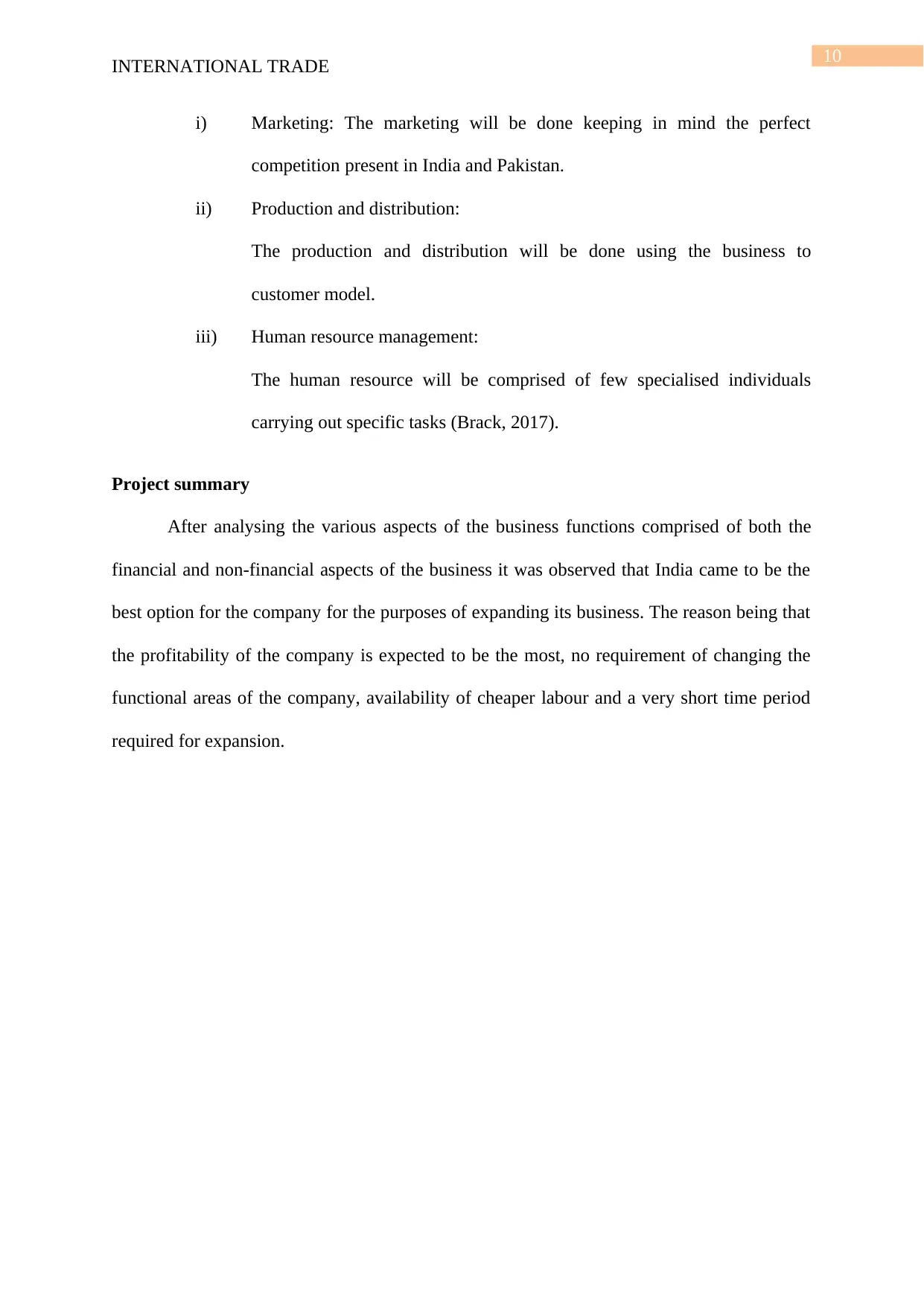
10
INTERNATIONAL TRADE
i) Marketing: The marketing will be done keeping in mind the perfect
competition present in India and Pakistan.
ii) Production and distribution:
The production and distribution will be done using the business to
customer model.
iii) Human resource management:
The human resource will be comprised of few specialised individuals
carrying out specific tasks (Brack, 2017).
Project summary
After analysing the various aspects of the business functions comprised of both the
financial and non-financial aspects of the business it was observed that India came to be the
best option for the company for the purposes of expanding its business. The reason being that
the profitability of the company is expected to be the most, no requirement of changing the
functional areas of the company, availability of cheaper labour and a very short time period
required for expansion.
INTERNATIONAL TRADE
i) Marketing: The marketing will be done keeping in mind the perfect
competition present in India and Pakistan.
ii) Production and distribution:
The production and distribution will be done using the business to
customer model.
iii) Human resource management:
The human resource will be comprised of few specialised individuals
carrying out specific tasks (Brack, 2017).
Project summary
After analysing the various aspects of the business functions comprised of both the
financial and non-financial aspects of the business it was observed that India came to be the
best option for the company for the purposes of expanding its business. The reason being that
the profitability of the company is expected to be the most, no requirement of changing the
functional areas of the company, availability of cheaper labour and a very short time period
required for expansion.
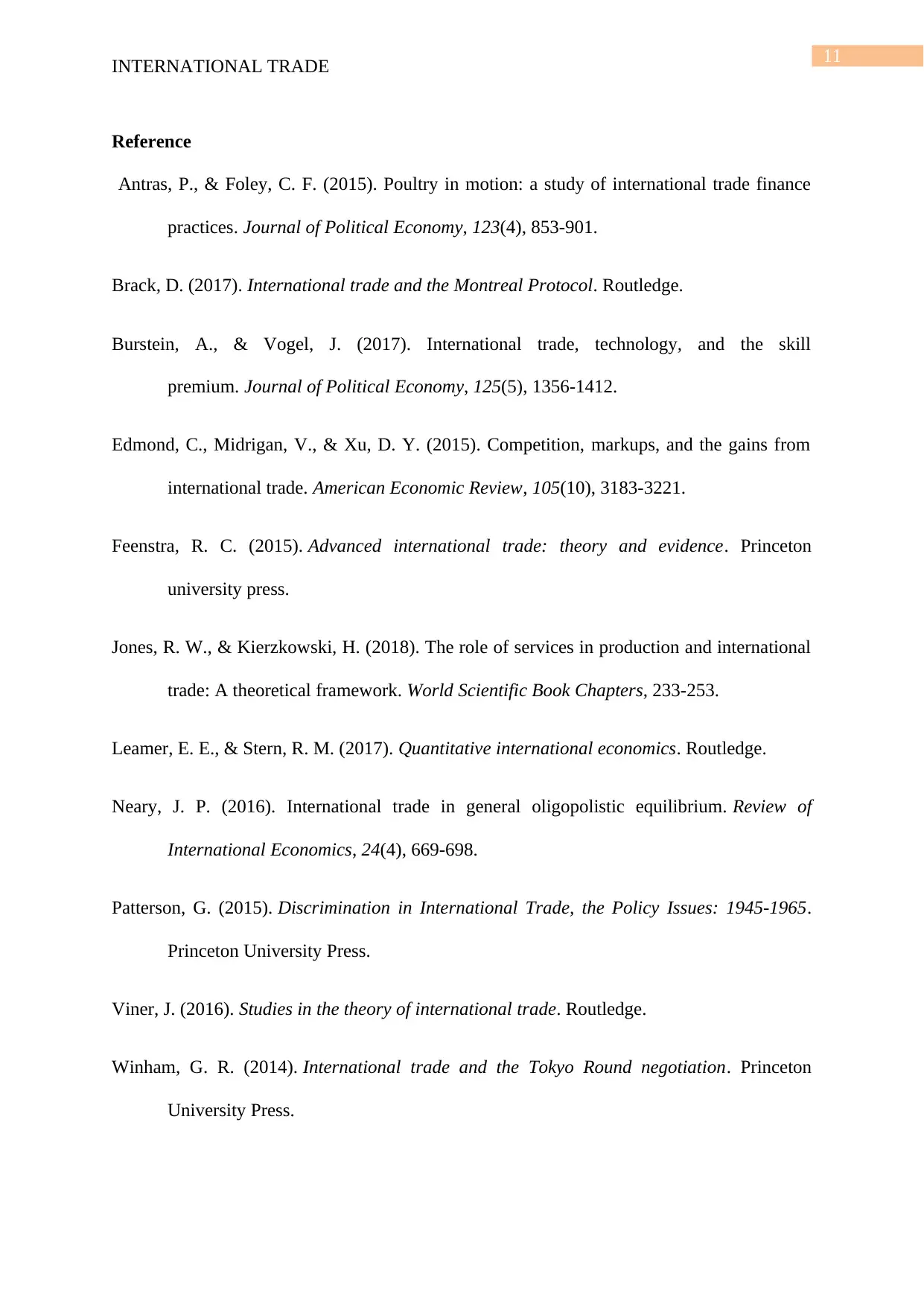
11
INTERNATIONAL TRADE
Reference
Antras, P., & Foley, C. F. (2015). Poultry in motion: a study of international trade finance
practices. Journal of Political Economy, 123(4), 853-901.
Brack, D. (2017). International trade and the Montreal Protocol. Routledge.
Burstein, A., & Vogel, J. (2017). International trade, technology, and the skill
premium. Journal of Political Economy, 125(5), 1356-1412.
Edmond, C., Midrigan, V., & Xu, D. Y. (2015). Competition, markups, and the gains from
international trade. American Economic Review, 105(10), 3183-3221.
Feenstra, R. C. (2015). Advanced international trade: theory and evidence. Princeton
university press.
Jones, R. W., & Kierzkowski, H. (2018). The role of services in production and international
trade: A theoretical framework. World Scientific Book Chapters, 233-253.
Leamer, E. E., & Stern, R. M. (2017). Quantitative international economics. Routledge.
Neary, J. P. (2016). International trade in general oligopolistic equilibrium. Review of
International Economics, 24(4), 669-698.
Patterson, G. (2015). Discrimination in International Trade, the Policy Issues: 1945-1965.
Princeton University Press.
Viner, J. (2016). Studies in the theory of international trade. Routledge.
Winham, G. R. (2014). International trade and the Tokyo Round negotiation. Princeton
University Press.
INTERNATIONAL TRADE
Reference
Antras, P., & Foley, C. F. (2015). Poultry in motion: a study of international trade finance
practices. Journal of Political Economy, 123(4), 853-901.
Brack, D. (2017). International trade and the Montreal Protocol. Routledge.
Burstein, A., & Vogel, J. (2017). International trade, technology, and the skill
premium. Journal of Political Economy, 125(5), 1356-1412.
Edmond, C., Midrigan, V., & Xu, D. Y. (2015). Competition, markups, and the gains from
international trade. American Economic Review, 105(10), 3183-3221.
Feenstra, R. C. (2015). Advanced international trade: theory and evidence. Princeton
university press.
Jones, R. W., & Kierzkowski, H. (2018). The role of services in production and international
trade: A theoretical framework. World Scientific Book Chapters, 233-253.
Leamer, E. E., & Stern, R. M. (2017). Quantitative international economics. Routledge.
Neary, J. P. (2016). International trade in general oligopolistic equilibrium. Review of
International Economics, 24(4), 669-698.
Patterson, G. (2015). Discrimination in International Trade, the Policy Issues: 1945-1965.
Princeton University Press.
Viner, J. (2016). Studies in the theory of international trade. Routledge.
Winham, G. R. (2014). International trade and the Tokyo Round negotiation. Princeton
University Press.
⊘ This is a preview!⊘
Do you want full access?
Subscribe today to unlock all pages.

Trusted by 1+ million students worldwide
1 out of 13
Related Documents
Your All-in-One AI-Powered Toolkit for Academic Success.
+13062052269
info@desklib.com
Available 24*7 on WhatsApp / Email
![[object Object]](/_next/static/media/star-bottom.7253800d.svg)
Unlock your academic potential
Copyright © 2020–2025 A2Z Services. All Rights Reserved. Developed and managed by ZUCOL.





